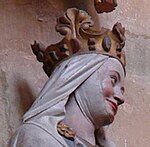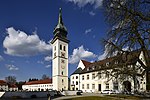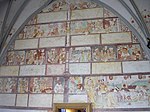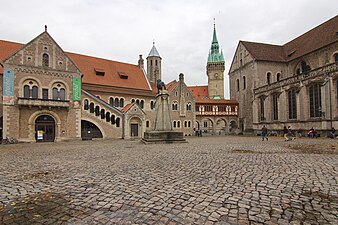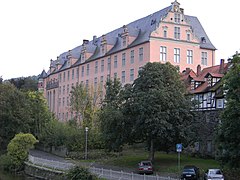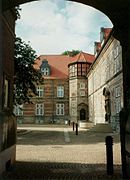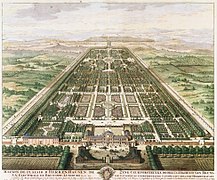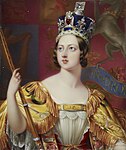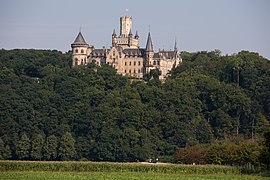Guelphs

The Guelphs have been documented since the 8th century and, along with the Capetians and Reginars, are the oldest still existing high nobility in Europe. The dynasty reached its first peak of power in the High Middle Ages in the Holy Roman Empire , when it provided dukes of Bavaria and Saxony and an emperor as a competitor to the Hohenstaufen dynasty . In modern times , the Guelphs were once again at their zenith, when they rose to be elector and kings of Hanover and kings of Great Britain and Ireland . The current head of the Guelphs is Ernst August von Hannover .
overview
The originally Franconian family , from the Meuse - Moselle area , was closely related to the Carolingian imperial family, which they enfeoffed with a county in Upper Swabia and a sideline in 888 with the Kingdom of Burgundy . With Welf III. , Duke of Carinthia and Margrave of Verona , the male line died out in 1055. Then his sister Kunigunde married into the northern Italian family d'Este , from which the younger Guelphs descended. These were - with interruptions - from 1070 to 1180 the dukes of Bavaria, from 1137 to 1180 the dukes of Saxony and from 1235 the dukes of Braunschweig-Lüneburg .
In 1692 the ruling line in the Principality of Calenberg-Göttingen was electoral in Hanover. With George I, the Guelphs ascended the British throne as heirs to the Stuarts in 1714 , which they held until 1901. The electorate was elevated to the Kingdom of Hanover at the Congress of Vienna in 1814 and ruled by the British monarchs in personal union until 1837. After that, the son of the English king who was sent to Germany ruled , whose successor went into exile in 1866 after the annexation of Hanover by Prussia . An older line ruled in the Principality of Braunschweig-Wolfenbüttel , which became the Duchy of Braunschweig in 1814 . After this line became extinct in 1884, the Brunswick throne fell to the Hanoverian line living in exile in Austria, which was only able to take it in 1913. Their rule ended on November 8, 1918 with the abdication of Ernst August , the last Duke of Guelph, as a result of the November Revolution .
history
A distinction is made between the older and the younger Guelphs, with the older ones also between the Burgundian (also called Rudolfinger) and Swabian Guelphs, whose ancestral castle was near Weingarten (Altdorf) in the Schussental . The relationship between these two lines is likely due to the similarity of names, but not certain. The origin of the name Welf (Italian: Guelfi , English: Guelph ) is unknown. It was not until over 700 years after the early medieval family was first mentioned in a document that the Welfensage was created in the late Middle Ages (after 1485) to explain this name .
The older Guelphs
The Franconian-Burgundian Guelphs
According to the widely accepted view of Josef Fleckenstein , the Burgundian Guelphs come from the Franconian ruling class and appear in a document for the first time in the 8th century with Count Ruthard († around 790), who is considered one of the ancestors of the family and after 746 owned the Maas and Moselle , thus in the core area of Carolingian power, acquired. Since the middle of the 8th century, the Guelphs were also wealthy in Upper Swabia , the best known of which is their property in Weingarten (then Altdorf).
According to family legend , the Guelphs trace their family tree back to Edekon , a Hunnic or Scythian prince at the time of Attila around 450 and father of Odoacer . The established line of the family does not begin until Count Welf I (attested in 819 and, according to Fleckenstein, a descendant of Count Ruthard). He was undoubtedly one of the top ranks in the Frankish Empire , because he succeeded in securing his position of power by marrying his two daughters Judith († 843) and Hemma († 876) with two Carolingians , Emperor Ludwig the Pious († 840), their son and Successor of Charlemagne, and with his son, King Ludwig the German († 876), to expand and consolidate.
Welf's son Konrad the Elder was one of the closest confidants of his brother-in-law, Emperor Ludwig the Pious, and took part in the mediation of the inheritance between his sons. First he built up a strong position of power in Upper Swabia , through marriage he also acquired property in western France and became Count of Paris in 849 . In 859 he switched from the side of his brother-in-law Ludwig the German to the side of his rival and half-brother Karl the Kahlen , the son of his sister Judith, whereby he lost all offices and counties in eastern France, but was compensated in the west by the county of Auxerre . He founded the Burgundian line of the Guelphs, which in 888 ascended the throne of the Kingdom of Burgundy (Hochburgund) with his grandson Rudolf I and in 1032 with Rudolf III. went out. With Adelheid , wife of Otto the Great , this line also represented an early Empress of the Holy Roman Empire .
Welf II , probably another son of Konrad, became Count in Linzgau and Alpgau and is the progenitor of the Swabian Guelphs, although the family relationships not only between him and Konrad, but also between him and his descendants are not exactly known. Only with Rudolf I, who is attested in 935, and his brother Konrad , who is known as Saint Konrad of Constance, and both of whom can be great-grandchildren of Welf II, does certain information come in again.
Welf I. , attested from 819, father-in-law of two Carolingians, Ludwigs the Pious († 840) and Ludwigs the German († 876)
Empress Judith (* around 795; † 843), daughter of Welf I.
Queen Hemma (* 808; † 876), daughter of Welfs I.
Empress Adelheid (* 931; † 999), wife of Otto the Great , daughter of Welf Rudolf II , King of Burgundy
The Swabian Guelphs
The Swabian Guelphs based their power on extensive allodial and feudal holdings in Swabia , Raetia and Bavaria .
Came around the middle of the 9th century, the average Schussental as county Schussen gau in possession of the Swabian branch of the Guelph (by Josef Fleckenstein originally francs from the Meuse-Moselle) occurring in Altdorf one on the Martinsberg Palatinate built their new family seat . Around 935 the Welfs founded a women's monastery in Altdorf, which was intended as a burial place (family grave) for their sex, but was destroyed by fire in 1053. The nuns were first relocated to the Martinsberg. Welf III, a great-grandson of Rudolf I, was appointed Duke of Carinthia in 1047 , but with him the male line also died out eight years later.
The name and property of the Guelphs passed to the son of his sister Kunigunde or Kunizza, who had married the Italian margrave Alberto Azzo II d'Este about twenty years earlier ; he is the progenitor of the younger Guelphs from the Este family ; like the Guelphs, they were originally a Frankish family from Charlemagne's circle , whom he had entrusted with the administration of counties in Lombardy .
Ancestral castle and later Weingarten Abbey , burial place and house monastery of the Swabian Guelphs
The Veitsburg in Ravensburg
Kunigunde, sister of Welfs III., The last older Welfin , and her husband Alberto Azzo II. D'Este
The younger Guelphs (House Welf-Este, Dukes of Bavaria and Saxony, from 1070)
Welf IV , the son of Kunigunde and Alberto Azzo, was appointed Duke of Bavaria by King Henry IV in 1070 . In 1056 Welf IV founded a new Benedictine monastery on Altdorfer Martinsberg after the relocation of the ancestral castle near Altdorf to the neighboring Veitsburg near Ravensburg on the Altdorfer Martinsberg , which was populated by monks from Altomünster , today's Weingarten Abbey ; In return, the Altdorf nuns settled in the Altomünster monastery. In 1073 Welf IV also founded the Rottenbuch monastery as an Augustinian canons' monastery, in which he was buried.
With Welf IV and his sons Welf V and Heinrich the Black , the time began when the family played the central role in the empire in opposition to the Staufers , especially after Heinrich, through his marriage to Billungerin Wulfhild, heiress of the territories around Lüneburg, which established the position of power of the Guelphs in Saxony, as well as their son Heinrich the Proud through his marriage to Gertrud von Sachsen , the only daughter of Emperor Lothar III. whose Brunon property around Braunschweig and, towards the end of his life, also acquired the title of Duke of Saxony . While the ducal offices in Bavaria and Saxony were hereditary flag loans of the empire, which could also be withdrawn as such, the inherited household goods in Swabia and now also in Lower Saxony were allodial property , which formed the real estate of the family.
Welf IV. , First Guelph Duke of Bavaria (* around 1035; † 1101)
Rottenbuch Abbey , Foundation (1073) Welfs IV.
The Guelph house monastery Steingaden , founded in 1147 by Welf VI., With the Romanesque Guelph Minster
Welf V. , Duke of Bavaria (around 1073–1120), with Mathilde von Tuszien
Heinrich the Black , Duke of Bavaria (1075–1126) and Wulfhild, heiress to the Billungers around Lüneburg
Heinrich the Proud (around 1102–1139), Duke of Bavaria and Saxony and Gertrud of Saxony (1115–1143), heiress of the Brunones around Braunschweig
Welf VI. (1115–1191), Margrave of Tuszien, brother of Henry the Proud
However , the Guelphs did not initially succeed in taking the step towards Roman-German kingship , which was indicated by the dual rule in the two largest duchies of the empire . In place of Heinrich the Proud, the Staufer Konrad III was established in 1138 . elected - Heinrich's abundance of power and his temperament seemed too threatening to the other princes. When Konrad asked Heinrich to renounce one of his two duchies, a dispute broke out, the imperial ban was imposed on Heinrich and both duchies were withdrawn. Heinrich was able to protect Saxony against all attacks, but he died a year later, before he was 32 years old.
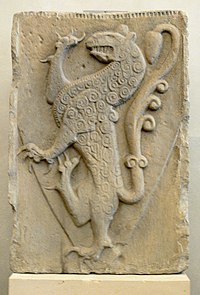
After the death of Heinrich the Proud, his brother Welf VI took over . the management of the house and the administration of the Guelph family estates in Swabia , since Henry the Lion , the only son of Henry the Proud, was not yet of legal age. In 1142 he managed to get from Konrad III. to achieve the return of the Duchy of Saxony to Henry the Lion. Margrave Welf VI. founded the Premonstratensian monastery Steingaden in 1147 as another house monastery, next to Weingarten and Rottenbuch. He was buried next to his pre-deceased son Welf VII in Steingadener Welfenmünster; twelve older Guelphs, who died between 990 and 1126, are buried in the Basilica of St. Martin in Weingarten, including Welf II , Welf III. , Welf IV. , Welf V. and Henry the Black .
As early as 1120, Judith, the sister of Heinrich the Proud and Welf VI, was married to Friedrich von Staufen , Duke of Swabia , in order to bring about a balance between the Staufers and Guelphs. From this marriage the future emperor Friedrich Barbarossa emerged, who in 1151 a reconciliation between his uncle Konrad III. and its Guelph cousins. Konrad died in 1152 and Friedrich was his successor. In the course of the reconciliation, Henry the Lion received the Duchy of Bavaria back in 1156 . Welf VI. became Duke of Spoleto and thus the most powerful man in Imperial Italy , as he ruled over Sardinia as a margrave of Tuscia due to his relationship with the House of Este . In the Tübingen feud (1164–1166), the dependence of the emperor on the greats of the empire was revealed, as was the complexity of the relations between the rulers, which cannot be reduced to the Staufer-Guelph opposition .
When Welf VI's only son, Welf VII , died of malaria in 1167 , the father lost his interest in further domestic power politics and bequeathed the old Welf home estates in Swabia, namely Ravensburg and Altdorf with the monastery, to his nephew Friedrich I Barbarossa by inheritance contract Vineyards, which have now been added to the Hohenstaufen estates; His other nephew, Heinrich the Lion, remained by far the most powerful prince in the empire and thus his arch rival through his ducal offices in Bavaria and Saxony, the Billungian-Brunonian estates in Lower Saxony and since 1167 as the son-in-law of the English king Heinrich II Cousin, the Staufer emperor.
Heinrich the Lion , Duke of Bavaria and Saxony (around 1130–1195)
Mathilde of England , wife of Henry the Lion, sister of Richard the Lionheart
As a result, there were renewed conflicts between Barbarossa and the lion, in the course of which Heinrich, however, lost out. He lost not only his duchies of Bavaria and Saxony (1179 outlawed , 1180 withdrawing the two ducal fiefs, but he kept his inherited privately owned by Brunswick and Lüneburg), but he had to go into exile in England, to the court of his father. The power of the Guelphs in Germany was broken, Saxony was divided (the Westphalian parts were detached and transferred to the Archbishop of Cologne, the rest of the Duchy was given to the Ascanians , the Duchy of Bavaria was transferred by the Emperor to his loyal follower Otto I von Wittelsbach , whereby he established the rule of the Wittelsbach family until 1918 ).
After a reconciliation with the Emperor in 1194, Henry the Lion got some of his property and title back, but the battle between the Staufers (allied with the French royal house of the Capetians and with Aragon ) and Welfen (allied with the House of Anjou - Plantagenet ) continued and was reflected above all in the internal Italian disputes between the party loyal to the emperor and the party loyal to the pope (the Ghibellines and Guelphs , the former being named after the Italian name for Waiblingen , an ancestral seat of the Hohenstaufen, and the latter after the Italian word for Guelph ).
Emperor Otto IV (around 1175–1218), son of Heinrich the Lion and Mathilde
Heinrich V , Count Palatine of the Rhine (around 1173–1227), son of Henry the Lion
Dankwarderode Castle with the Brunswick Cathedral , residence of Henry the Lion
The Brunswick lion
German king and emperor (Staufer-Guelph throne dispute 1198–1214 / 15)
A final flare-up of the Guelph opposition was the election of Otto IV , son of Henry the Lion, in 1198 as the rival king of Philip of Swabia . After his assassination in 1208 Otto was in 1209 by Pope Innocent III. crowned the first and only Welf Emperor of the Holy Roman Empire , but shortly afterwards he was banned from church because of his attempt to incorporate Sicily into the empire . In 1214 Otto was defeated by the French King Philip II August in the Battle of Bouvines , which weakened him so much that he no longer had any serious chances in the controversy for the throne with Friedrich II von Hohenstaufen , who had been elected opposing king in 1212. Otto IV died in the Harzburg in 1218 , Friedrich II was his successor. Via Otto's niece Agnes, daughter of Heinrich des Langen , in 1214 the Electoral Palatinate fell to Bavaria from the Welfs to the Wittelsbachers, who also ruled them until 1918.
Duchy of Braunschweig-Lüneburg (1235–1806)

The Duchy of Braunschweig-Lüneburg was created from the property of the Welfs in Saxony . This was Otto the child , a grandson of Henry, as part of a compensation formally the lion on Emperor Frederick II. Transmitted and received on August 21, 1235 on the court day to Mainz as a fiefdom back. It was named after the two largest cities in the area, Braunschweig and Lüneburg . The duchy only existed as a general rule until the first division in 1269. In the southern part of the duchy, the principality of Braunschweig emerged with possessions around Braunschweig, Wolfenbüttel , Einbeck and Göttingen . In the northern part of the duchy the Principality of Lüneburg was established with possessions in the Lüneburg area. Both partial principalities continued to form the Duchy of Braunschweig-Lüneburg , which under imperial law continued to exist as an undivided imperial fief for the Guelph family. In the partition agreement it was agreed that both lines should carry the title "Duke of Braunschweig and Lüneburg". In addition, a number of possessions and rights should remain in the possession of the entire house - including the rights to Braunschweig Castle . It was divided several times over the centuries that followed. The states that emerged again and again were usually named after their respective residence, such as the Principality of Göttingen , the Principality of Grubenhagen or the Principality of Calenberg . The different lines could inherit each other if one line became extinct. So over the centuries the old, medium and new house in Braunschweig, as well as the old, medium and new house in Lüneburg were built. The number of part dynasties ruling at the same time ranged between two and five. The partial principalities existed until the end of the Holy Roman Empire of the German Nation in 1806. In the end, the older line ruled the Principality of Braunschweig-Wolfenbüttel and the younger the Electorate of Braunschweig-Lüneburg (or Electorate of Hanover ).
Duchy of Brunswick (1814–1918)

After the Congress of Vienna , the Duchy of Braunschweig, which existed until 1918, was created for the older line . It was identical to the territory of the Guelph Principality of Braunschweig-Wolfenbüttel and the Principality of Blankenburg , which had been incorporated into the Kingdom of Westphalia during the French occupation from 1807 to 1813 . It consisted of several, non-connected parts: the area between Aller and Harz with Braunschweig, the area between Harz and Weser with Holzminden, Blankenburg am Harz with its surroundings, the Calvörde office (included by the province of Saxony), the Thedinghausen office between Bremen and Verden and other exclaves. The New House of Braunschweig, which ruled the small duchy, was the older line of the Guelphs alongside the Hanoverian line. It died out in 1884 with the heirless Duke Wilhelm .
The Duchy of Brunswick was in 1884 after the death of William to the living in the Austrian exile leader of the younger Guelph Line, the Crown Prince of Hanover Ernest Augustus, Duke of Cumberland , Fallen (1845 to 1923). At the instigation of Bismarck , the Federal Council rejected the claimed reign. From 1884 to 1913, princes from Prussia and Mecklenburg held the reign. It was only through the marriage of his son Prince Ernst August (1887–1953) to Princess Viktoria Louise , the only daughter of the last German Emperor Wilhelm II , that the Duchy of Braunschweig was again taken over by the Guelphs. As the last Guelph Duke, Ernst August ruled the state of Braunschweig from the Hanoverian line from 1913 to 1918. After the November Revolution in Braunschweig in 1918, it became the Free State of Braunschweig .
Wolfenbüttel Castle , first attested in 1074
Hessen Castle , originally a medieval moated castle
Blankenburg Castle , built around 1123
Fürstenberg Castle on the Weser , documented around 1300
Schöningen Palace , built in 1350 as a hunting lodge
Salzdahlum Castle , inaugurated in 1694
The newly built Braunschweig Castle (2007; first construction from 1717)
Small castle in Blankenburg (Harz) , built in 1725, largely rebuilt in 1765
Richmond Castle in Braunschweig (1769)
Electorate of Braunschweig-Lüneburg and Kingdom of Hanover

The Guelph Principality of Calenberg-Göttingen was rewarded with the electoral dignity by Emperor Leopold I in 1692 as thanks for support in the Palatinate War of Succession . When the principality of Calenberg was awarded the electoral dignity, the electorate of Braunschweig-Lüneburg was formed . For this purpose, the emperor created the new (ninth) cure of the Holy Roman Empire in 1692 . The younger line of the Guelphs ruling in the Principality of Calenberg was awarded this ninth electoral dignity.
The new electorate was in what is now Lower Saxony and parts of the state of Saxony-Anhalt (with the offices of Calvörde and Blankenburg). It comprised the following territories of the Holy Roman Empire : Principality of Calenberg , Principality of Grubenhagen , County of Hoya , Duchy of Saxony-Lauenburg , Principality of Lüneburg (from 1705), the Duchy of Bremen and the Duchy of Verden (from 1715). Calenberg, Grubenhagen and Lüneburg were nominally partial principalities of the medieval duchy of Braunschweig and Lüneburg . Originally the electorate was a purely inland area (Hanover area). Only with the acquisition of the Duchy of Bremen could Kurhannover expand to the North Sea. The majority of the electorate was in the Lower Saxon Empire . The County of Hoya and the Duchy of Verden were part of the Lower Rhine-Westphalian Empire . Residences were the Leineschloss in Hanover as well as Herrenhausen Castle and Celle Castle .
The Kingdom of Hanover was established in 1814 at the Congress of Vienna as the successor state to the Electorate of Braunschweig-Lüneburg . Initially, until 1837, the king was also the king of the United Kingdom of Great Britain and Ireland .
In the German War of 1866 the Kingdom of Hanover lost the war against Prussia on the side of Austria and the German Confederation , was annexed and from then on was only a province in the Kingdom of Prussia. The Welfs, like the House of Hessen- Kassel, were dethroned by the Prussian Hohenzollern. The House of Hanover has represented the entire House of Braunschweig-Lüneburg since the death of the heirless - not childless - Duke Wilhelm of Braunschweig . All Welf family members bear the name "Prince (essin) of Hanover, Duke (in) of Braunschweig and Lüneburg".
Herzberg Castle in the Harz Mountains, 11th century
Harburg Castle , first mentioned around 1135
Calenberg Castle , built as a moated castle from 1292
Celle Castle , residence of the Principality of Lüneburg , rebuilt from 1378
Welfenschloss Münden , built from 1501 as a residential palace
Gifhorn Castle , built 1525–1581
Landestrost Castle , Neustadt am Rübenberge, built 1573–1584
The Leineschloss in Hanover, built from 1637
Herrenhausen Palace and Great Garden , built
from 1638Former Lüneburg Castle , built around 1700
Kings in the Kingdom of Great Britain and Ireland
The electoral house of Hanover ruled Great Britain and Ireland for five generations in personal union , which ended in 1837 after 123 years: Georg (e) I. (1714–1727), Georg (e) II. (1727–1760), Georg (e ) III. (1760-1820) and Georg (e) IV. (1820-1830). After the fall of the Holy Roman Empire in 1806, Georg IV, as Prince Regent, proclaimed the former Electorate of Braunschweig-Lüneburg to be the sovereign Kingdom of Hanover for his father in 1814.
After Georg (e) IV died childless in 1830, his brother Wilhelm IV became King of Great Britain, Ireland and Hanover. When this Wilhelm also died childless, his niece Victoria ascended the British throne as the last Welfin until her death in 1901. Victoria's husband, Prince Albert of Saxe-Coburg-Gotha , gave the former name Saxe-Coburg-Gotha of today's British royal family which was renamed House Windsor in 1917 .
George I (1714-1727)
George II (1727-1760)
Friedrich Ludwig von Hannover , Prince of Wales (1707–1751)
George III (1760-1820)
George IV (1820-1830)
Victoria (1819-1901)
Kings in the Kingdom of Hanover
Since the various laws of succession in Hanover only permitted a female heir to the throne if there was no male heir, Victoria could not become Queen of Hanover. Thus, her uncle, the Duke of Cumberland, Ernst August I. 1837 became the first independently ruling King of Hanover (1771-1851). After his death, his son Georg V succeeded him to the throne as King of Hanover (1819–1878). His reign was ended in 1866 by the Prussian annexation after Georg V had sided with the (defeated) Austrian side in the Austro -Prussian War in 1866.
Coat of arms of the Kingdom of Hanover 1837
Ernst August I , King of Hanover (1771–1851)
George V , King of Hanover (1819–1878)
King George V went with his wife, Queen Marie of Austria into exile. He died in Paris in 1878, where the Guelph Legion had set up against Prussia, which is why Bismarck had confiscated the King's private fortune in the amount of 16 million thalers in 1868 and transferred it to the Guelph Fund , the proceeds of which were initially used "to combat Guelf activities". George V was buried in the royal tomb of Windsor Castle. His widow lived in the queen's villa in Gmunden until her death . Her grandson, Prince Ernst August (1887–1953), married Princess Viktoria Luise of Prussia in 1913 , the only daughter of the last German Emperor, Wilhelm II , and was thus able to ascend the vacant throne of the Duchy of Braunschweig.
After the First World War
With the fall of the German monarchies in 1918, Duke Ernst August zu Braunschweig and Lüneburg also had to abdicate. He and his family went into exile in Austria at Cumberland Castle , which his father had already built in Gmunden. The management of the entire building was entrusted to Paul Knoke .
The family returned to the Free State of Braunschweig in 1925 . this awarded the former ducal family, among other things, Blankenburg Castle and the Hesse domain in what is now the Harz district . Ernst August, the son-in-law of the former German emperor, successfully asserted himself as a freelance entrepreneur and changed the primary family name from Braunschweig-Lüneburg back to Hanover in 1931 , whereby the official family name (also in the passport and civil status documents) is still today: Prince / Princess of Hanover Duke / Duchess of Braunschweig and Lüneburg Royal Prince / Royal Princess of Great Britain and Ireland . The family members have German, British and Austrian citizenship; the British family name is Guelph with the addition of His / Her Royal Highness . However, since the outbreak of the First World War had entered a rift between the ruling royal family and its German branch line in 1914, was the last Hanoverian Crown Prince Ernst August on 13 May 1915 by King George V of the Order of the Garter revoked and on March 28, 1919 due to the Titles Deprivation Act of 1917, which stripped "enemies of the British Empire" from their British peerage, the British title 3rd Duke of Cumberland and Teviotdale, 3rd Earl of Armagh stripped. However, the theoretical eligibility of the Guelphs for this title was maintained.
In the course of the Second World War , especially in the last months of the war, the Guelphs were also indirectly involved in the exploitation of forced laborers through arms deals . According to the Potsdam Agreement , in July 1945 the Soviet Army a. a. Blankenburg and the "Domain Hessen". The family was able to take some of the movables with them to the Marienburg with the help of trucks of the British Army , where they temporarily withdrew. The castle is now open to the public as a family museum. Together with the lands of the Calenberg domain , it is managed by Prince Ernst August (* 1983 in Hildesheim ), who also owns the Herrenhausen Princely House . His father Ernst August lives on the Austrian estates.
Ernst August , last ruling Duke of Braunschweig (1887–1953)
Viktoria Luise von Prussia (1892–1980), wife of Duke Ernst August
Cumberland Castle , Gmunden (Upper Austria)
Marienburg Castle near Hanover
The most important Guelphs
| The main members of the family | ||
| in the history of Western France and the Kingdom of Burgundy | ||
| Surname | Domination | Remarks |
|---|---|---|
| Hugo Abbas | († 866 ) tutor of the kings Odo and Robert I. | |
| Rudolf I , King of Burgundy | 888-912 | |
| Rudolf II , King of Burgundy | 912-937 | King of Italy 922–926, of Niederburgund from 930 |
| Conrad III. the peacemaker , King of Burgundy | 937 / 951-993 | |
| Rudolf III. , King of Burgundy | 993-1032 | |
| in the history of the Holy Roman Empire | ||
| Surname | Domination | Remarks |
| Welf III. , Duke of Carinthia | 1047-1055 | |
| Welf IV , Duke of Bavaria |
1070-1077 and 1097-1101 |
|
| Welf V. , Duke of Bavaria | 1101-1120 | |
| Welf VI. , Duke of Spoleto | 1152-1191 | |
| Heinrich the Black , Duke of Bavaria | 1120-1126 | |
|
Heinrich the Proud , Duke of Bavaria, Duke of Saxony |
1126-1138 1137-1139 |
|
|
Heinrich the Lion , Duke of Saxony, Duke of Bavaria |
1142-1180 1156-1180 |
|
| Otto IV , German king, emperor from 1209 | 1198-1218 | |
| in the history of Great Britain and Ireland | ||
| Surname | Domination | Remarks |
| George I , King | 1714-1727 | |
| George II , King | 1727-1760 | |
| George III , King | 1760-1820 | |
| George IV , King | 1820-1830 | |
| William IV , King | 1830-1837 | |
| Victoria , queen | 1837-1901 | |
| in the history of Hanover | ||
| Surname | Domination | Remarks |
| Ernst August , Elector | 1679-1698 | |
| Georg I. Ludwig , Elector | 1698-1727 | |
| George II , Elector | 1727-1760 | |
| George III , King | 1760-1820 | |
| George IV , King | 1820-1830 | |
| Wilhelm , king | 1830-1837 | |
| Ernst August , King | 1837-1851 | |
| George V , King | 1851-1866 | |
Guelphs
The anti-imperial party of the Guelphs was named after the Guelphs in medieval Italy and was opposed to the Hohenstaufen and later against the subsequent emperors.
See also

- Annales Welfici about the southern German Guelphs between 1101 and 1184
- Tribe list of the Guelphs
- Guelph Order
- Guelph treasure
- Crown of the Kingdom of Hanover
- German-Hannoversche Party (Guelph Party )
- High nobility
Morganatic and extramarital descendants :
- Counts of Eppan (in South Tyrol), allegedly illegitimate descendants of the older Guelphs, extinct in 1300
- Lüneburg (noble family) , descendants of August the Elder
- Count of Platen Hallermund (descendants of Elector Ernst August with Sophia Charlotte von Platen-Hallermund )
- The three daughters of George I with Melusine von der Schulenburg
- George FitzClarence, 1st Earl of Munster (and 9 other illegitimate children of William IV )
swell
- Sources on the history of the Guelphs and the chronicle of Burchard von Ursberg , edited and translated by Matthias Becher with the collaboration of Florian Hartmann and Alheydis Plassmann (= selected sources on German history in the Middle Ages. Freiherr-vom-Stein-Gedächtnisausgabe. Vol. 18b). Darmstadt 2007, ISBN 978-3-534-07564-5 .
literature
Overarching
- Hans-Georg Aschoff : The Guelphs. From the Reformation to 1918. Kohlhammer, Stuttgart 2010, ISBN 978-3-17-020426-3 .
- Josef Fleckenstein : About the origin of the Guelphs and their beginnings in southern Germany. In: Studies and preliminary work on the history of the Greater Franconian and early German nobility (= research on the history of the Upper Rhine region. Vol. 4). Edited by Gerd Tellenbach . Albert, Freiburg 1957, pp. 71-136.
- Rudolf Schieffer : Rudolfinger. In: New German Biography (NDB). Volume 22, Duncker & Humblot, Berlin 2005, ISBN 3-428-11203-2 , pp. 198-200 ( digitized version ).
- Georg Schnath : The Welfen House as a European dynasty. In: ders .: Forays through Lower Saxony's past. Collected essays and lectures by Georg Schnath. Lax, Hildesheim 1968, pp. 126-145.
- Bernd Schneidmüller : The Guelphs. Rule and memory. Kohlhammer, Stuttgart 2000, ISBN 3-17-014999-7 ; 2nd edition 2014 (only covers the period from the 9th to the 13th centuries)
- Thomas Vogtherr : The Guelphs. From the Middle Ages to the present. Beck, Munich 2014, ISBN 978-3-406-66177-8 .
- Heinz Schießer : The Welfen at the Traunsee - 130 years of Cumberland Castle in the Salzkammergut. MatrixMedia Verlag, Göttingen 2017, ISBN 978-3-946891-02-4 .
- Ines Elsner: The tribute silver of the Guelphs of the New House Braunschweig-Lüneburg (1520-1706). Schnell & Steiner, Regensburg 2019, ISBN 978-3-7954-3355-0 .
Medieval aspects
- Werner Hechberger , Florian Schuller (eds.): Staufer and Welfen. Two rival dynasties in the High Middle Ages. Pustet, Regensburg 2009, ISBN 978-3-7917-2168-2 ( review ).
- Werner Hechberger: Staufer and Welfen 1125–1190. On the use of theories in history. Böhlau, Cologne 1996, ISBN 3-412-16895-5 .
- Gudrun Pischke: The divisions of the Guelphs in the Middle Ages. Lax, Hildesheim 1987, ISBN 3-7848-3654-2 .
-
Detlev Schwennicke : European family tables . Stargardt, Marburg 1978ff. and Klostermann, Frankfurt a. M.
- Vol. 1/1. The Franconian kings and the kings and emperors, tribal dukes, electors, margraves and dukes of the Holy Roman Empire of the German Nation. Klostermann, Frankfurt am Main 1989, ISBN 3-465-02743-4 .
- Vol. 3/4. Feudal France and its influence on the world of the Middle Ages. Stargardt, Marburg 1989, ISBN 3-87775-022-2 and ISBN 3-465-02716-7 .
Early modern and modern aspects
- When the royals came from Hanover . 4 volumes. Sandstein, Dresden 2014, ISBN 978-3-95498-103-8 .
- Ronald G. Asch (Ed.): Hanover, Great Britain and Europe. Experience space personal union 1714–1837 (= publications of the Historical Commission for Lower Saxony and Bremen. 277). Wallstein, Göttingen 2014, ISBN 978-3-8353-1584-6 .
- Jeremy Black : The Hanoverians. The History of a Dynasty. Hambledon and London, London et al. 2004, ISBN 1-85285-446-4 .
Web links
Remarks
- ↑ Josef Fleckenstein: About the origin of the Guelphs and their beginnings in southern Germany. In: Studies and preliminary work on the history of the Greater Franconian and early German nobility (= research on the history of the Upper Rhine region. Vol. 4). Edited by Gerd Tellenbach. Albert, Freiburg 1957, pp. 71-136. The has Wolfgang Hartung objected: The origin of Guelph from Alamannia. In: Karl-Ludwig Ay , Lorenz Maier , Joachim Jahn (eds.): Die Welfen. Regional historical aspects of their rule (= Forum Suevicum. Vol. 2). UVK, Konstanz 1998, pp. 23-55 ( digital copy , PDF ). Werner Hechberger pointed out the pitfalls of personal historical research on the Middle Ages with “sometimes somewhat bold hypotheses” : Nobility in the Franconian-German Middle Ages. Ostfildern 2005, pp. 306–328, here p. 316.
- ↑ Josef Fleckenstein: About the origin of the Guelphs and their beginnings in southern Germany. In: Studies and preliminary work on the history of the Greater Franconian and early German nobility (= research on the history of the Upper Rhine region. Vol. 4). Edited by Gerd Tellenbach. Albert, Freiburg 1957, pp. 71-136, here pp. 105-107.
- ^ The princes of the independent principality of Braunschweig-Wolfenbüttel also called themselves dukes of Braunschweig and Lüneburg.
- ^ Abdication of Duke Ernst August zu Braunschweig and Lüneburg. Digital version of the certificate of abdication, Lower Saxony State Archives .
- ^ Nobility without scruples - The dark business of the Guelphs. ( Memento from September 10, 2014 in the Internet Archive ) Story in the First, August 18, 2014. In addition, the dossier The Dark Businesses of the Welfs. In: NDR.de , August 18, 2014; Dieter Bartetzko : Old nobility, dark past. In: Frankfurter Allgemeine Zeitung , August 17, 2014; Gustav Seibt : How the Guelphs benefited from Aryanization. In: Süddeutsche.de , August 18, 2014.



